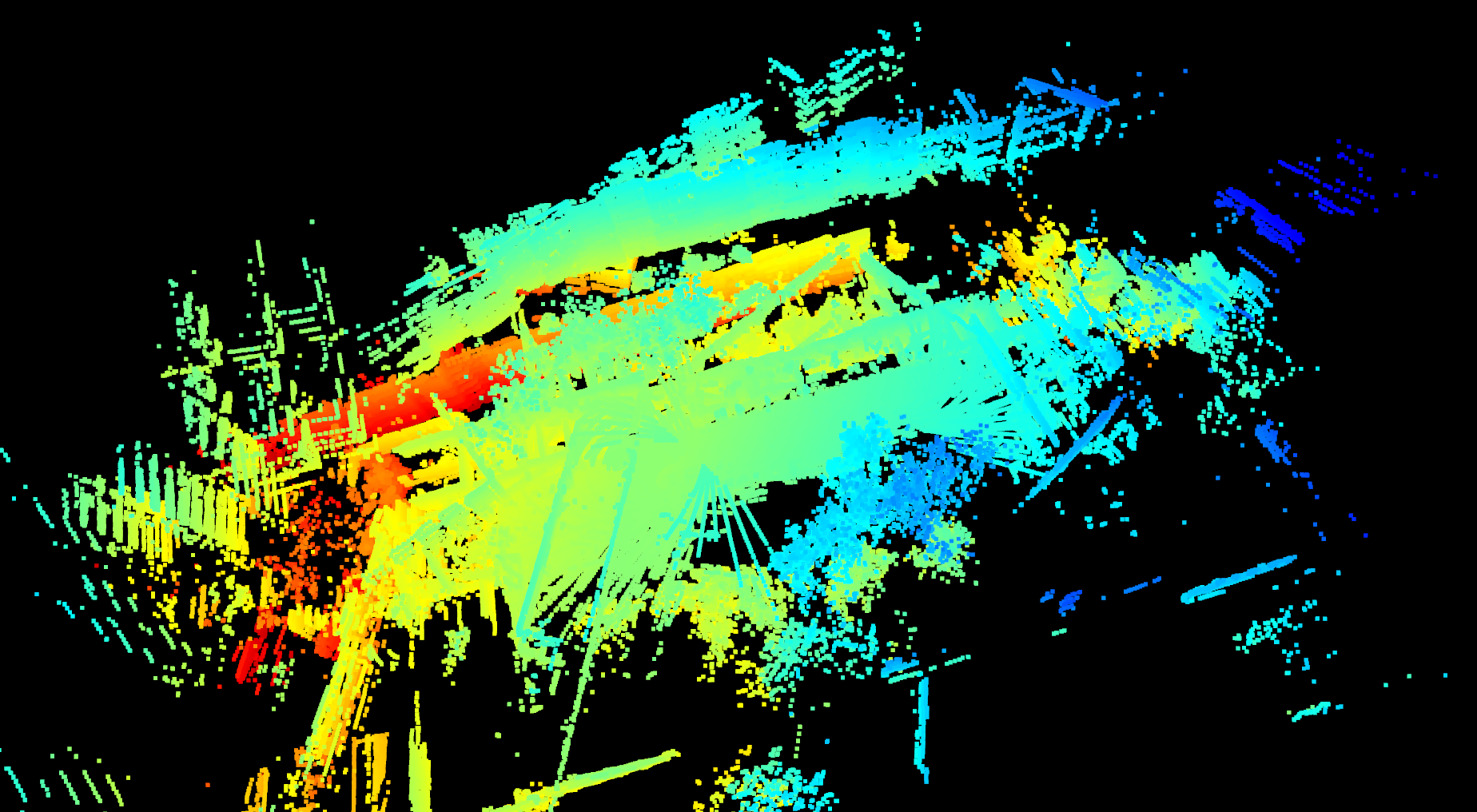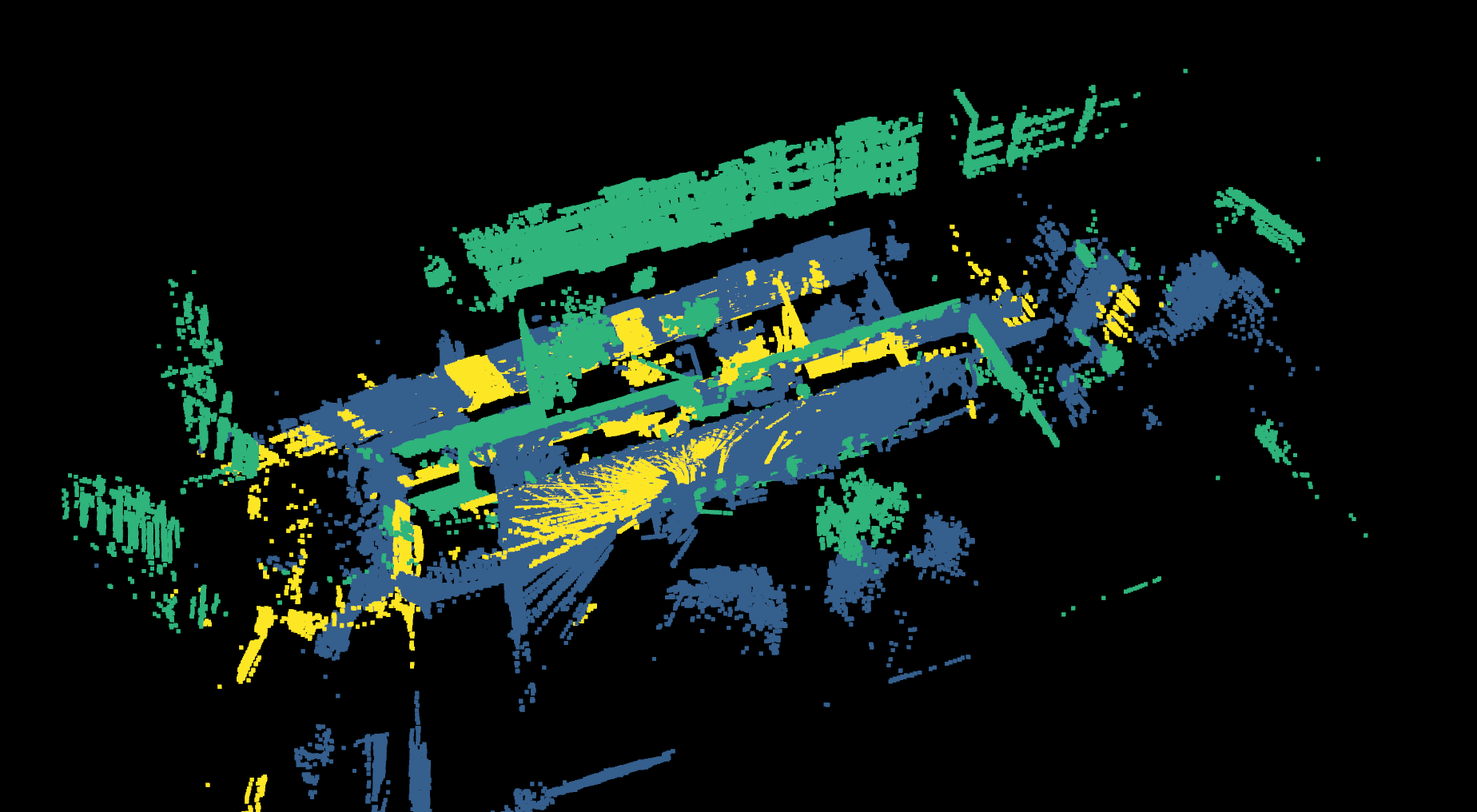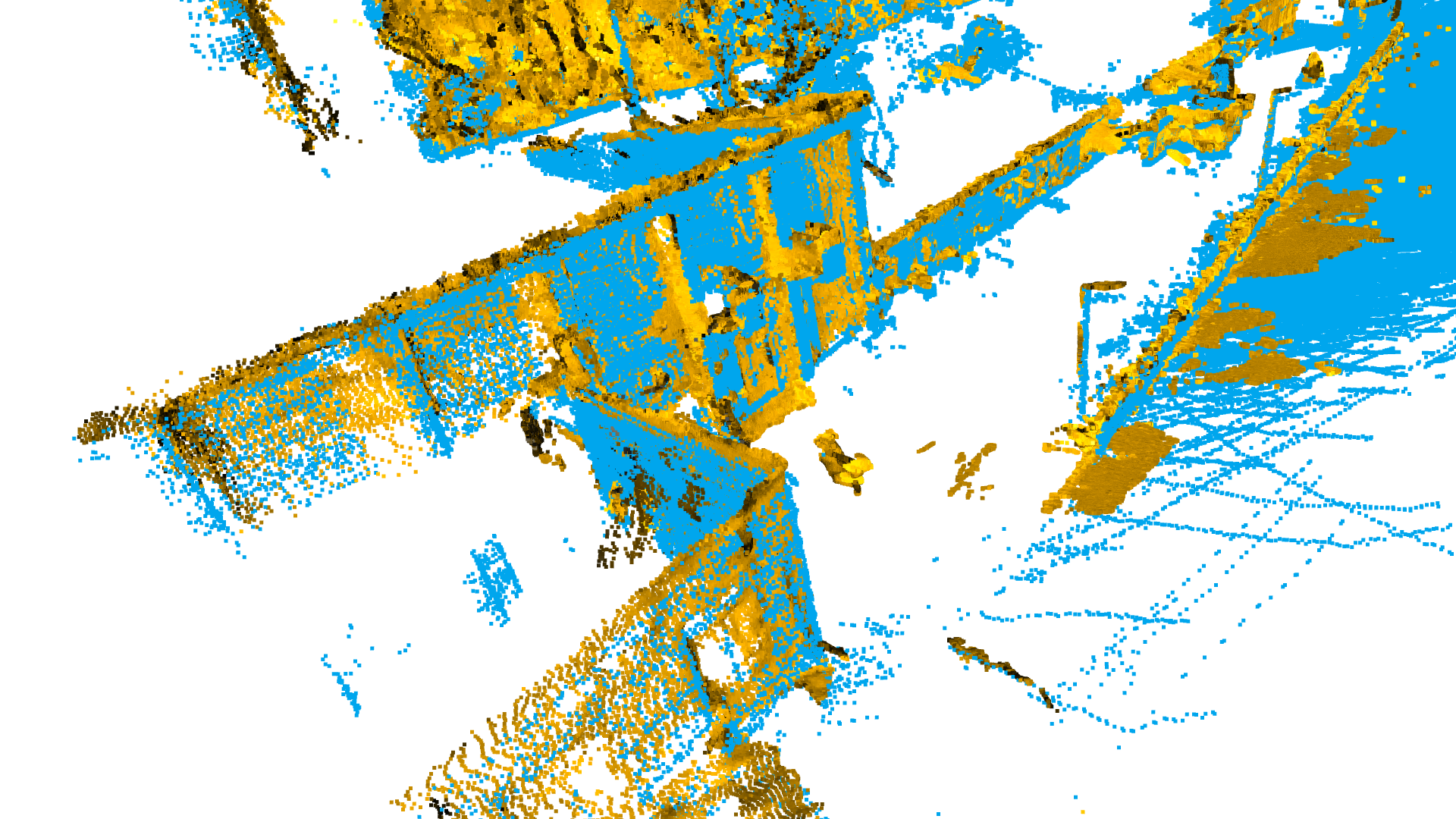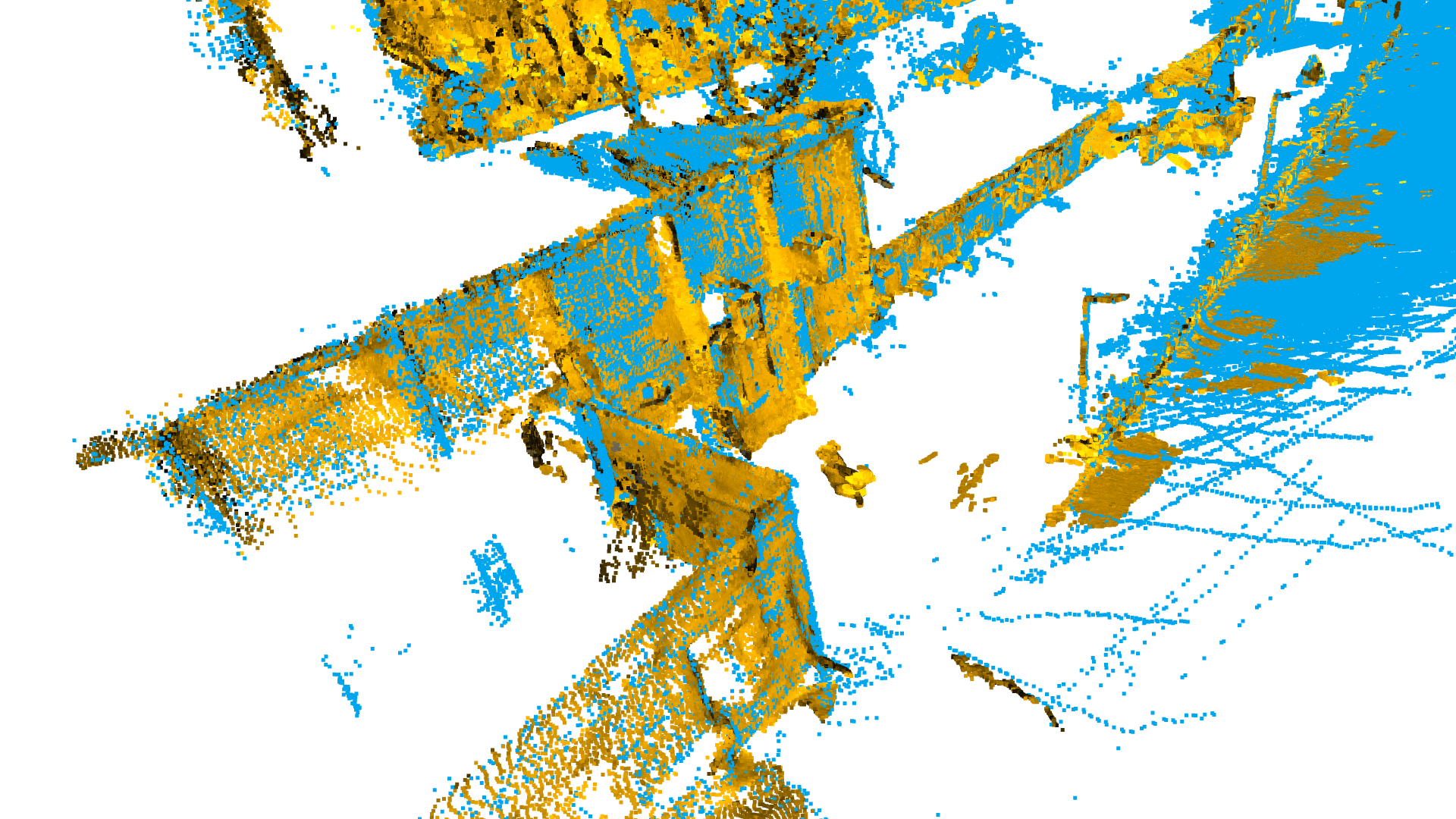Official Implementation of the paper "Targetless Extrinsic Calibration of Camera and Low-resolution 3-D LiDAR".
- Paper: [IEEE]|[TechRxiv]
- Data: Our data is now available for reproduction.
- All advices, citations, support will be acknowledged and appreciated.
- Feel free to propose any issues you met.
- Thanks for citing our work:
@ARTICLE{10097551,
author={Ou, Ni and Cai, Hanyu and Yang, Jiawen and Wang, Junzheng},
journal={IEEE Sensors Journal},
title={Targetless Extrinsic Calibration of Camera and Low-Resolution 3-D LiDAR},
year={2023},
volume={23},
number={10},
pages={10889-10899},
doi={10.1109/JSEN.2023.3263833}}
- Ubuntu 18.04/20.04 or Windows 10
- Python 3.8 or later
- g++ 7 or later
- cmake 3.1.0 or later
- OpenMVG
- OpenMVS
- MinkowskiEngine
- Open3D (pip install open3d) (0.15.2)
- scikit-learn (pip install scikit-learn)
how to install OpenMVG
Install OpenMVG according to https://github.com/openMVG/openMVG/blob/develop/BUILD.md. Remember to use `-DOpenMVG_USE_OPENMP=ON` flags for camke. (if you have OpenMP)| Proposed Calibration | Checkboard Calibration |
|---|---|
 |
 |
You can use view_projection.py and our data to generate similar figures.
You need to add sychronized image and LiDAR data to the respective directories ./data/img and ./data/pcd first. If you do not have your own data currently, please feel free to download our data for testing. It is recommended to capture images around one object (such as a building or a cluster of buildings) for the sake of SFM performance.
mkdir data && cd data
mkdir img
mkdir pcdUse our cpp tools to preprocess LiDAR data and save to ./data/proc_pcd. (Remove the backward 180 degrees of each LiDAR scan)
cd cpp
mkdir build && cd build
cmake ..
make
./preprocess ../../data/pcd ../../data/proc_pcdThis preprocess pipeline is accelearted by OpenMP. When it finishes, you can use ./view xxx.cpd to verify whether the pcd has been correctly filtered.
Please ensure your OpenMVG has been installed propoerly before this step. SequentialSfM engine is suitable for this task empircally. Run path/to/OpenMVG/build/software/SfM/SfM_SequentialPipeline.py with input args input_dir and output_dir. After you finished this step, the resultant sfm_data.json can be found in path/to/output_dir/reconstruction_sequential/.
If you are a beginner of OpenMVG or need troubleshooting
If you are a beginner of OpenMVG, please follow our intructions to use the doc/SfM_SequentialPipeline.py file to implement SfM.
To use it, you need to follow some simple steps:
- replace all
path/to/OpenMVGstrings in the script with your specific OpenMVG installation directory. - give the intrinsic parameters of your camera. You may put it into an ASCII-coded file or just modify the
intrinsicvariable in the above python script. Fortunately, coarse instrinsic paramters are also OK, as SfM will estimate them simultaneously. - run the command
python Sfm_SequentialPipeline.py input_dir output_dir ins_file. Theinput_diris the directory containing all your raw images while theoutput_diris the directory you designate to store all resultant files of OpenMVG. Note that if you choose to modify theintrinsicvariable in the last step. Please just leave out the third argumentins_file. - After it finishes running, you will find a
sfm_data.jsonfile inpath/to/output_dir/reconstruction_sequential/.
Please ensure your Open3D has been installed properly in your python environment before this step.
First, set global name paramters in config.yml:
work_dir: building_imu
res_dir: res
method: ranregYou can name it freely, as they are just basic names for creating files and directories, but DO NOT change them during the following steps.
Then, run multiway_reg.py for initial point cloud registration.
python multiway_reg.py --input_dir data/proc_pcd After that, you will see ranreg_raw.json in res_dir/work_dir, which is a Open3D PoseGraph with initial estimated LiDAR poses.
Please wait a few minutes. This process is the most time-consuming part of our framework.
Modification on other args
- step: use 1 pcd file per
stepfiles. Please change this argument carfully, as the pcd poses should keep consistent with the numebr of camera poses. - pose_graph: the name of the resultant PoseGraph. If you change this arg, please keep it constant in the following steps.
- voxel_size: the downsampling voxel size. Smaller size leads to better registration performance as a pay for efficiency.
- radius: radius to compute information matrix. A larger radius will consider a larger range of points into surface alignment.
- ne_method: we implement normal estimation different from Open3D.
o3dindicates using the original Open3D Normal Estimation, but it performs worse in low-resolution laser scans.
- To start with, use RANSAC hand-eye calibration to extract inlier LiDAR poses:
python TL_solve_ransac.py --camera_json /path/to/sfm_data.json --pcd_json /path/to/ranreg_raw.jsonThis process (Cluster Extraction) will genrate inlier LiDAR poses to res/work_dir/clique_ranreg.json. The work_dir parameter is manually set in TL_solve_ransac.py. To vividly show this process, we display two pictures below. For principles, please see Section IV A-B in our paper.
| Raw graph (ranreg_raw.json) | Clique Extraction (clique_ranreg.json) |
|---|---|
 |
 |
- Now the raw graph have been splited into several inlier subgraphs. At the next stage, we refine each subgraph with Multiway Registration:
python clique_split_refine.py --input_dir data/proc_pcd --clique_file /path/to/clique_ranreg.json --init_pose_graph ranreg_raw.jsonYou will get clique_desc_ranreg.json and a clique_ranreg folder in the res_dir/work_dir, which is the same directory of clique_desc_ranreg.json.
- Now each subgraph has been refined, we need to integrate them together. Please ensure your MinkowskiEngine has been properly installed before this step.
Downlaod FCGF model and put it to ./FCGF dir. Rename it to kitti_v0.3.pth.
python clique_merge_refine.py --input_dir data/proc_pcd --clique_desc clique_desc_ranreg.json --feat_method FCGFThis process (Clique Integration) consolidate each subgraph into one. The resultant figure:
Meanwhile, you will get ranreg_union.json in res_dir/work_dir. Use reconstruction.py to view it in Open3D Viewer and generate ranreg_union.pcd, the merged point cloud from inlier laser scans.
python reconstruction.py --input_dir data/proc_pcd --pose_graph ranreg_union.json --clique_file <res_dir>/<work_dir>/clique_ranreg.jsonConduct hand-eye calibration among inliers using TL_solve.py.
python TL_solve.py --camera_json /path/to/sfm_data.json --pcd_json /path/to/ranreg_union.json --save_sol res/work_dir/ranreg_sol.npzThis process generates the calibration results with the input of inlier cmaera and lidar poses in ranreg_sol.npz
NB: use --gt_TCL_file if you have a ground-truth extrinsic matrix, or just omit it and the output evaluation.
Please ensure your OpenMVS has been properly installed and undistorted_images and scene.mvs has been generated in path/to/output_dir/reconstruction_sequential/. dir during your Step 2.
- Densify Point Cloud
cd OpenMVS_build/build/bin
./DensifyPointCloud /path/to/scene.mvs -w /path/to/work_dir/open_mvs/This process densifies the reconstruction of SfM and generate a dense color point cloud using undistored images.
After it finished, you should see scene_dense.ply and scene_dense.mvs in path/to/reconstruction_sequential/. You can also use ./Viewer /path/to/scene_dense.mvs to check it.
- Scene Registration (SR)
python Reg7D.py --camera_pcd /path/to/scene_dense.ply --lidar_pcd /path/to/ranreg_union.pcd --TL_init /path/to/TL_ranreg_sol.npzThe Reg7D.py script aligns the camera reconstruction to the lidar one using the intial sim3 transformation solved from Step 5. You will get ranreg_tcl.txt, which is the final result of our method. The comparison before and after Scene Registration is shown below:
| Before SR | After SR |
|---|---|
 |
 |

